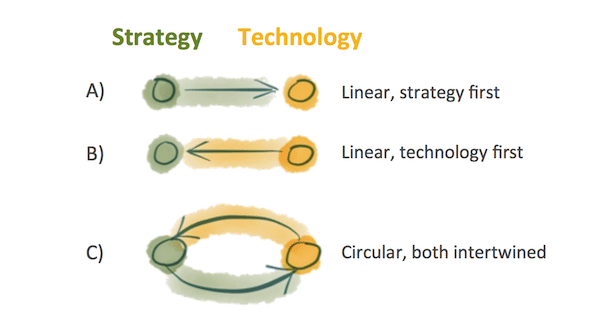Scott Brinker has another must-read post. I excerpt parts of his post below so I can expand on it a bit but you should read his full post along with the comments.
In his post Scott explains he is responding to statements made in a podcast by Joe Pulizzi and Robert Rose. After linking to the podcast and agreeing with much of what they say Scott makes three points:
- “Marketing technology is not just about efficiency — it’s about experiences.
- The relationship between strategy and technology is circular, not linear.
- Marketers cannot abdicate their responsibility to understand technology.”
and mentions the one quote he really disagrees with (emphasis is Scott’s):
“Figure out your process first. And then get aligned with your internal IT guys to figure out what it is you exactly need to facilitate. Because that’s the only thing that technology will ever, ever do. The only thing technology will ever do is facilitate a process that you have more efficiently. That’s all it’s ever going to do.”
That is a pretty strong recommendation for option A in Scott’s illustration below.
I want to make three points:
The fact that the relationship between technology and strategy is circular – that they have to inform, influence, and advance with each other – is true of all enterprise applications and for all functions and has always been true.
- If you replace “technology” with “data” or “big data” or “analytics” the points that Scott makes are equally valid. (For a different take on this see Big data and decision making: data vs intuition.)
- Technology is not just a set of product features. The features are possible because of creative combinations of underlying software concepts, programming languages, data structures, and architectures. Without some understanding of the underlying fundamentals it is natural to think product features define software capabilities and thus to limit insight into strategy possibilities. Marketers (or other professionals) with little to no technical background can compare feature sets and build strategies that match, or build strategies and look for the set of already existing product features to match.
- Each of these illustrate what we might call the bad kind of circularity (as we mean when we call an argument circular) and they handicap innovation. The good kind of circularity is a strategy/technology dialog of what ifs, informed by what might be possible, not by what is already known.
It is both natural and common for consultants to overemphasize option A, because way too often option B is overemphasized at the expense of option A by both their customers and technology vendors. Good consultants spend a lot of time and effort helping customers overcome an under-appreciation or political deprecation of the importance of strategy. But all of us need to be careful not to suggest either linear false choice.



Leave a Reply
You must be logged in to post a comment.